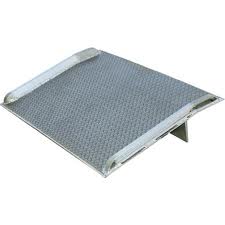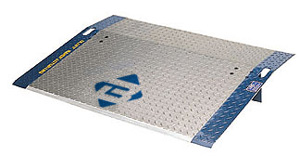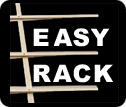|
  If you've spent any time at all in material handling, shipping/receiving, or straight warehouse work, you've run into the situation where having truck dockboards could have saved you a world of headaches. You've seen mismatched trailer deck to dock heights. If you've been in the industry long enough, you've seen all sorts of situations where what are sometimes called dock or trailer ramps would have or did come on quite handy. If you've spent any time at all in material handling, shipping/receiving, or straight warehouse work, you've run into the situation where having truck dockboards could have saved you a world of headaches. You've seen mismatched trailer deck to dock heights. If you've been in the industry long enough, you've seen all sorts of situations where what are sometimes called dock or trailer ramps would have or did come on quite handy.


A Truck DockBoard Can Save Your Back with Mismatched Trailer Heights:
Normally, when a truck dock is built, there's a standard that it's built to. That is, the height above the ground at which the dock edge is built is standardized, because, normally, the trailer deck's height of above the ground is also standardized. But sometimes you'll run into a situation where the trailer deck is three or four inches above or below the height of the edge of the dock. Unless you have something like dock ramps in the warehouse, forget getting in and out of the trailer without exerting your back muscles.
Bridge That Gap Between Dock and Trailer Deck:
 Even when the heights of both trailer deck and loading dock are exactly matched, you're going to run into occasions where the gap between them is too large and either prohibits you being able to drive a forklift into the trailer, especially loaded, or roll a pallet jack or hand cart over the gap. Having a truck dock board will bridge that gap and allow you to load and unload with ease. Even when the heights of both trailer deck and loading dock are exactly matched, you're going to run into occasions where the gap between them is too large and either prohibits you being able to drive a forklift into the trailer, especially loaded, or roll a pallet jack or hand cart over the gap. Having a truck dock board will bridge that gap and allow you to load and unload with ease.
Driver Docking Error Can Raise Havoc with Trailer Loading and Unloading
Those of us that have spent any significant time in the warehousing field have seen this one at least once. The driver that's in a hurry to get his (or her) next load and get on the road backs the trailer up at an angle to your dock, drops the butterfly stands, unhooks, and takes off to get their next load, leaving a gap of two inches on one side of the trailer, and eight or none on the other side. Unless you have truck dockboards in the warehouse, or someone with a tractor that can reposition the trailer, you're going to be stuck unloading/loading that trailer by hand. But, drop the truck dock ramps into place, and run the forklifts and pallet jacks in and out to your heart's content.
There Are a Number of Different Types of Truck Dockboards Available
There are two basic types of truck dockboards; those that are built into the end of the dock and those that aren't. The built-in variety can be further broken down to manual and automatic truck ramps. Both kinds lift up out of the floor, unfold, and then bridge the gap between the trailer and the dock. These are heavy-duty and quite hard to damage.
The other kind of truck dock board is portable. This means you can move it between docks as needed. Some are pretty heavy-duty, allowing you to roll heavy forklifts up and down without causing damage to the ramp. Some have guides on the sides to keep you from inadvertently stepping or rolling off the edges.
Which kind of truck dockboards you needs all depends on the types of materials being loaded and unloaded and the methods of loading and unloading at your warehouse.
|
